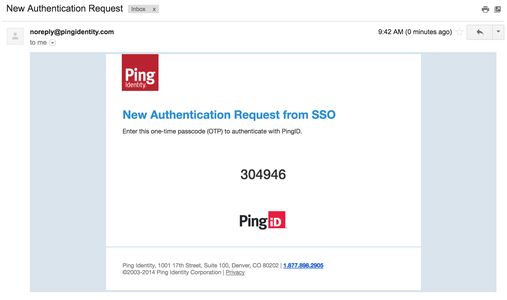Setup one-time passcodes
PingOne supports several methods of multi-factor authentication (MFA), which is the practice of requiring more than one type of evidence to identify a user. For example, a username and password together are considered a single factor.
Adding more authentication factors, such as one-time passcodes, helps to strengthen your security posture and reduce the chance of a data breach.
To learn more, refer to Single-factor, Two-factor, and Multi-factor Authentication in the Identity Fundamentals documentation.
The Ping SDKs help you to integrate authentication flows that use one-time passcodes into your client applications.
The Ping SDKs support the following one-time passcode delivery methods:
-
When email authentication is configured, and the user signs on to their account or app, they are sent an email with a one-time passcode (OTP) to authenticate with.
 Figure 2. Receiving an OTP via email
Figure 2. Receiving an OTP via emailThe OTP is valid for up to 30 minutes.
- SMS
-
When configured, a one-time passcode (OTP) is sent to the user’s mobile device as a text message using SMS.
 Figure 3. Receiving an OTP via SMS
Figure 3. Receiving an OTP via SMSThe OTP is valid for up to 30 minutes.
- Voice
-
When configured, a one-time passcode (OTP) is sent to the user’s mobile device or landline phone using telephony voice channels. The OTP is valid for up to 30 minutes.
Steps
Complete the following steps to integrate one-time passcode authentication into your client applications: